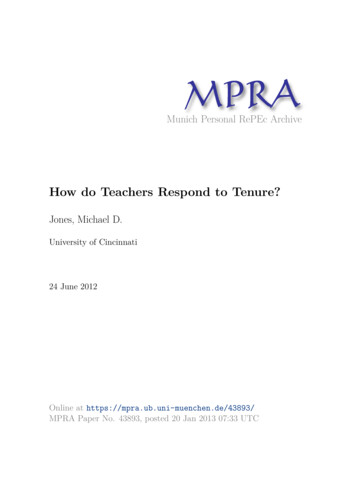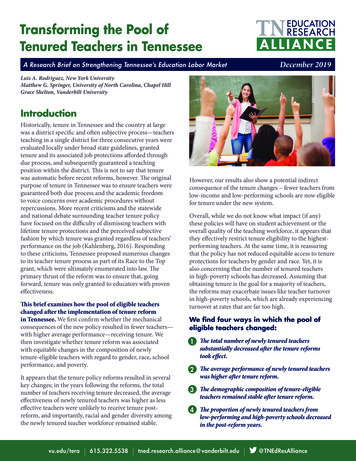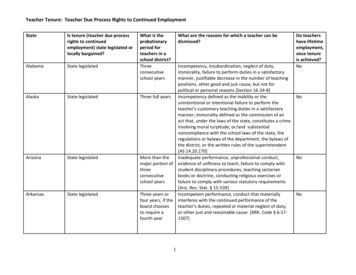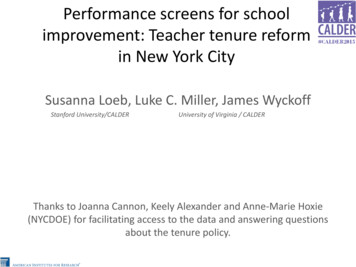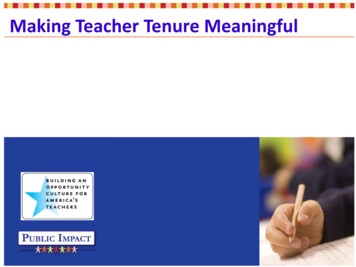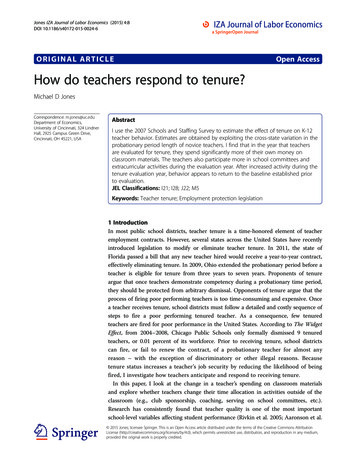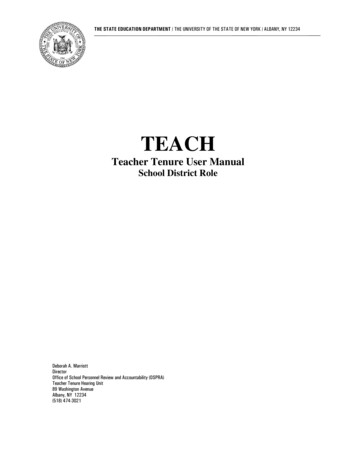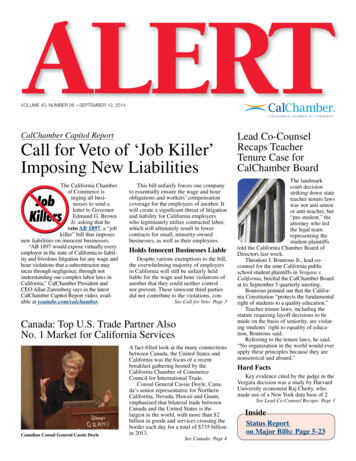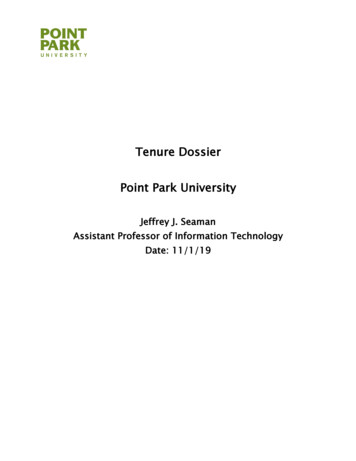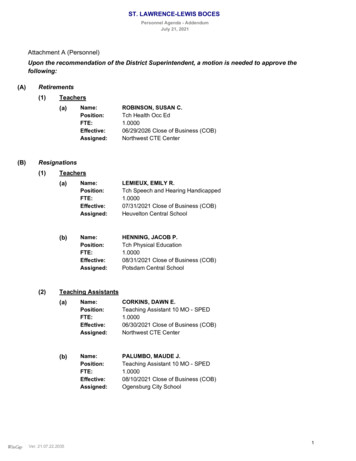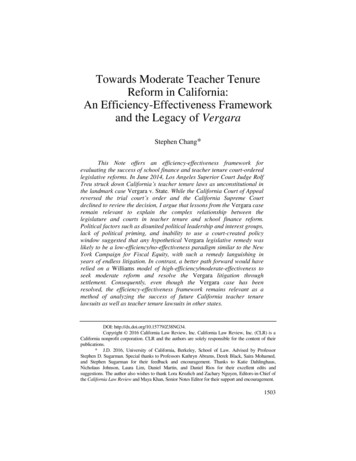
Transcription
Towards Moderate Teacher TenureReform in California:An Efficiency-Effectiveness Frameworkand the Legacy of VergaraStephen Chang*This Note offers an efficiency-effectiveness framework forevaluating the success of school finance and teacher tenure court-orderedlegislative reforms. In June 2014, Los Angeles Superior Court Judge RolfTreu struck down California’s teacher tenure laws as unconstitutional inthe landmark case Vergara v. State. While the California Court of Appealreversed the trial court’s order and the California Supreme Courtdeclined to review the decision, I argue that lessons from the Vergara caseremain relevant to explain the complex relationship between thelegislature and courts in teacher tenure and school finance reform.Political factors such as disunited political leadership and interest groups,lack of political priming, and inability to use a court-created policywindow suggested that any hypothetical Vergara legislative remedy waslikely to be a low-efficiency/no-effectiveness paradigm similar to the NewYork Campaign for Fiscal Equity, with such a remedy languishing inyears of endless litigation. In contrast, a better path forward would haverelied on a Williams model of high-efficiency/moderate-effectiveness toseek moderate reform and resolve the Vergara litigation throughsettlement. Consequently, even though the Vergara case has beenresolved, the efficiency-effectiveness framework remains relevant as amethod of analyzing the success of future California teacher tenurelawsuits as well as teacher tenure lawsuits in other states.DOI: http://dx.doi.org/10.15779/Z38NG34.Copyright 2016 California Law Review, Inc. California Law Review, Inc. (CLR) is aCalifornia nonprofit corporation. CLR and the authors are solely responsible for the content of theirpublications.* J.D. 2016, University of California, Berkeley, School of Law. Advised by ProfessorStephen D. Sugarman. Special thanks to Professors Kathryn Abrams, Derek Black, Saira Mohamed,and Stephen Sugarman for their feedback and encouragement. Thanks to Katie Dahlinghaus,Nicholaus Johnson, Laura Lim, Daniel Martin, and Daniel Rios for their excellent edits andsuggestions. The author also wishes to thank Lora Krsulich and Zachary Nguyen, Editors-in-Chief ofthe California Law Review and Maya Khan, Senior Notes Editor for their support and encouragement.1503
1504CALIFORNIA LAW REVIEW[Vol. 104:1503Introduction . 1504I. The Vergara Litigation . 1507A. School Finance Litigation: A Brief History . 1508B. The Litigation History of Vergara . 1509C. Reactions to and Criticism of the Vergara Trial CourtDecision . 1516D. Vergara as Judicial Activism . 1519II. An Efficiency-Effectiveness Framework for Evaluating School FinanceCourt-Ordered Legislative Remedies . 1522A. The Efficiency-Effectiveness Framework . 1522B. High-Efficiency/High-Effectiveness in Kentucky: Rose v.Council for Better Education . 1525C. Low-Efficiency/Moderate-Effectiveness: New Jersey’sThirty-Year Robinson and Abbott Litigations . 1528D. Low-Efficiency/No-Effectiveness: New York’s Campaign forFiscal Equity and its “March of Folly” . 1530E. High-Efficiency/Low-Effectiveness: California’s ReedSettlement . 1534F. High-Efficiency/Moderate-Effectiveness: California’sWilliams Settlement . 1535G. Conclusion: What Matters in the School Finance RemediesProcess . 1537III. Predicting the Legacy of Vergara . 1538A. Political Factors Applied to the Vergara Case. 1540IV. Toward a Williams High-efficiency/Moderate-effectivenessSettlement . 1544A. Permanent Employment Statute. 1546B. Dismissal Statutes . 1547C. LIFO (Last-In-First-Out) Firing in an Economic Crisis . 1548D. The Legacy of Vergara: Reform by Initiative . 1549E. The Effect of Plaintiffs’ Loss on Appeal . 1549F. The Legacy of Vergara and the future of Teacher TenureReform . 1550Conclusion . 1551INTRODUCTIONYou spend thousands of hours and millions of dollars litigating a case thatis supposed to change the very future of education in your state. The judgefinds that the constitutional violation you allege has deprived children of anequal educational opportunity. You’ve won the case, but the real battle is onlyjust beginning.
2016]MODERATE TEACHER TENURE REFORM IN CALIFORNIA1505The history of school finance litigation demonstrates that the politicalprocess formulating court-ordered legislative remedies is a critical factorinfluencing the ultimate impact of a given case. Sometimes these remedies aretremendously effective and accepted by all stakeholders without a fight. Morelikely, the remedy is so ineffective that another lawsuit is brought. The newlawsuit is appealed, another legislative remedy ordered, another lawsuit filed.A vicious cycle begins. Before you know it, a dozen years have passed withnext to nothing (or little or nothing) in results to speak for your case other thanan exceptionally long ping-pong match between the legislature, the courts, theexecutive, and other interest groups. This convoluted remedies process couldhave been one potential fate for the plaintiffs in the Vergara teacher tenurelawsuit where plaintiffs—even if successful on the merits—would have had tonavigate a political minefield in the legislative remedies process that wouldlikely lead to inefficient and ineffective reform.This Note is the first to offer to the literature on school finance litigationan efficiency-effectiveness framework for evaluating the success of courtordered legislative remedies. Further, this is the first work to apply such aframework to the ongoing new wave of Vergara-style teacher tenure litigation.On June 10, 2014, California State Court Trial Judge Rolf Treu issued hislong-awaited decision in Vergara v. State, effectively striking down fiveteacher tenure statutes that had long provided protections for grossly ineffectiveteachers as unconstitutional under the California Equal Protection Clause.1 OnApril 4, 2016, the California Court of Appeal for the Second Appellate Districtreversed Judge Treu’s decision.2 In a close 4-3 vote, the California SupremeCourt declined to hear the plaintiffs’ petition for review, allowing the Court ofAppeal’s decision to stand.3Plaintiffs, nine students from across California, brought suit alleging thatthe teacher tenure statutes in California denied them access to an equalopportunity for quality education because of their constant exposure to grosslyineffective teachers. The initial success of the Vergara suit spawned similarchallenges to teacher tenure laws across the country.41. No. BC484642, 2014 WL 6478415, at *1–3 (Cal. Super. Ct. 2014).2. Vergara v. State, 202 Cal. Rptr. 3d 262 (Ct. App. 2016). The court found that plaintiffsfailed to establish that the challenged statutes violated equal protection primarily because they “did notshow that the statutes inevitably cause a certain group of students to receive an education inferior tothe education received by other students.” Id. at *268–69. This Note was originally written before theappellate court’s decision was released in April 2016 and before the California Supreme Court’s denialof plaintiff’s petition for review. The effects of the successful appeal and the California SupremeCourt’s decision to decline review are discussed in Part IV below.3. Vergara v. State, No. B258589, 2016 WL 4443590, at *17 (Cal. Ct. App. Aug. 22, 2016).4. See, e.g., Mary Tillotson, Anti-Tenure Lawsuit Filed in New York, HEARTLAND INST.(Oct. 3, 2014), B99-G5QA] (describing the Partnership for Educational Justice litigation in NewYork where six parents are using Vergara as a litigation model). The lawsuit is being led in part byformer CNN Anchor Campbell Brown, who was recently featured on the Colbert Report promoting
1506CALIFORNIA LAW REVIEW[Vol. 104:1503This Note seeks to address three primary issues. First, I establish anefficiency-effectiveness framework drawn from case law and remediesprocesses in school finance. I argue that five distinct possibilities exist based onthis framework. These are (1) high-efficiency/high-effectiveness (Kentucky’sRose litigation), (2) low-efficiency/moderate-effectiveness (New Jersey’sRobinson and Abbott), (3) low-efficiency/no-effectiveness (New York’sCampaign for Fiscal Equity), (4) high-efficiency/low-effectiveness (California’sReed settlement), and (5) high-efficiency/moderate-effectiveness (California’sWilliams settlement). Second, I apply this framework to a hypothetical Vergaravictory and ultimately predict that political factors such as ineffective politicalpriming, political leadership, and interest group influence suggested that even ifplaintiffs had won on appeal, a Vergara remedy would likely have been a lowefficiency/no-effectiveness situation. Finally, I argue that in future teachertenure cases in both California and nationwide that both plaintiffs anddefendants must take notice of the inefficient and ineffective remedies likely toresult and seek a settlement to promote a high-efficiency/moderate-effectivenesscase similar to California’s Williams settlement. I further argue that this cantake place through either legislative reforms or initiative-based change.In Part I, I provide a brief explanation of why teacher tenure law is socontentious and offer some critiques of the controversial Vergara trial courtorder. In Part II, I establish the efficiency-effectiveness framework by analyzingthe long history of school finance remedies that preceded Vergara.5 I questionwhy some cases such as Rose v. Council for Better Education in Kentuckyresulted in highly efficient and highly effective legislature-driven changes inschool funding, while other cases such as New York’s Campaign for FiscalEquity languished with few substantive results despite numerous litigationvictories. I argue that political leadership and interest group politics are criticalfactors that can both positively and adversely influence the efficiency andeffectiveness of a judicially compelled legislative remedy. In Part III, I applythese factors to a hypothetical Vergara victory arguing that they suggested thatany Vergara court-ordered remedy would have languished as a lowefficiency/no-effectiveness example stuck in a cycle of endless litigation. Here,the modern phenomenon of the splintering Democratic Party is vital. In onewing, traditional pro-labor Democrats favor the status quo of quick tenure,strong dismissal rights for tenured teachers, and a Last-In-First-Out (LIFO)statute governing firing during an economic crisis. In contrast, what I will referto in this Note as Reformer Democrats stand as strange bedfellows with thethe Vergara-like suit. Campbell Brown, COLBERT REP. (July 31, 2014), ell-brown [https://perma.cc/XV4Y-W2FV]; see also Emmanuel Felton,Minnesota Faces a Vergara-Style Lawsuit on Teacher Job Protections, EDUC. WEEK (Apr. 14, 016/04/minnesota vergaga suit.html [htts://perma.cc/ZEM5-C4JV].5. I chose a very limited scope of cases out of the dozens of school finance cases filed acrossthe country as specific examples of different legislative remedy outcomes.
2016]MODERATE TEACHER TENURE REFORM IN CALIFORNIA1507conservatives who led the Vergara case in their desire to strike down quicktenure, weaken dismissal rights, and remove the LIFO statute.In Part IV, I argue that the best solution in future teacher tenure andschool finance lawsuits would be to seek a Williams-style highefficiency/moderate-effectiveness solution since Vergara has opened a policywindow ripe for a legislative response and that settlement of future casesthrough legislation is in the interests of all parties involved to avoid a cycle ofcostly litigation as in Campaign for Fiscal Equity. I offer potential moderatesettlement remedies that can serve as a blueprint for future teacher tenurelawsuit settlements that fit within the Williams high-efficiency/moderateeffectiveness paradigm. Further, I argue that one additional avenue to pursuethis goal is through the initiative system, by reviving a Schwarzenegger-eraproposal to increase the teacher tenure evaluation period.I.THE VERGARA LITIGATIONTeacher tenure reform frequently promotes emotional and wildly divisiverhetoric.6 The plaintiffs in Vergara heavily emphasized the “vital role” thatteachers play in public school education, taking for granted that “[t]he keydeterminant of educational effectiveness is teacher quality.”7 In contrast, thestate and teacher unions consistently emphasized that the firing of “grosslyineffective” teachers was a narrow focus in comparison to the problems facedin the public education system at large.8 Simply put, the Vergara plaintiffsviewed teacher quality through tenure reform as an utmost priority in reform,while their opponents viewed larger systemic issues, such as school finance9 orteacher preparation, among others, as a better direction for the reformconversation.Vergara was a challenge to five statutes in the California Education Codethat govern teacher tenure in the state. The first, section 44929.21(b), which thecourt termed the “Permanent Employment Statute,”10 mandates that all certified6. Compare Diane Ravitch, Vergara Decision Is Latest Attempt to Blame Teachers andWeaken Public Education, HUFFINGTON POST (June 11, 2014), -teacher-tenure b 5484237.html [https://perma.cc/2MB2-Z7JB] (construing Vergarato be a part of the “blame-shifting strategy of the privatization movement” against teachers), withGloria Romero, Students Stand up to the System, and Win, ORANGE COUNTY REG. (June 13, -618215-teachers-california.html [https://perma.cc/VDJ6SRF5] (characterizing Vergara as “historic” and arguing vehemently against appeal to “deliver on thepromise of education as the key to the American Dream”).7. First Amended Complaint at 3, Vergara v. State, No. BC484642, 2014 WL 6478415 (Cal.Super. Ct. 2014).8. State Defendants’ Points and Authorities in Support of Motion for Summary Judgment at11, Vergara, 2014 WL 6478415 (No. BC484642).9. See, e.g., Campaign for Fiscal Equity, Inc. v. State, 801 N.E.2d 326 (N.Y. 2003); RoblesWong v. State, No. RG10515768, 2011 WL 5902812 (Cal. Super. Ct. 2010).10. Vergara, 2014 WL 6478415, at *2.
1508CALIFORNIA LAW REVIEW[Vol. 104:1503employees (teachers) in California be “reelected for the next succeeding schoolyear” after employment for “two complete consecutive school years.”11Teachers must be notified “on or before March 15” of the second consecutiveschool year of employment of the district’s decision to “reelect or not reelect”the teacher for the next school year.12 Second, sections 44934, 44938(b)(1)(2),and 44944 (the Dismissal Statutes)13 involve procedural protections such as theNotice of Intention to Dismiss,14 Notice of Unprofessional Conduct orUnsatisfactory Performance,15 and Dismissal Hearing Procedures.16 Finally,plaintiffs also challenged the “Last-In-First-Out (LIFO) Statute,” whichrequires seniority-based layoffs such that the newest teachers are fired beforeolder teachers.17 Together, these statutes are referred to as the “ChallengedStatutes.”A. School Finance Litigation: A Brief HistoryIt is prudent to briefly discuss the history of impact litigation influencingeducation reform in California to understand the context of Judge Treu’s trialcourt decision. In a sense, Vergara can be seen as a next-generation impactlitigation suit following the guidance of cases such as Brown v. Board ofEducation, Serrano v. Priest, and Butt v. California.18 Further, Vergara followsin the footsteps of school finance case law, discussed in Part II.In Brown v. Board of Education, Chief Justice Earl Warren held for aunanimous court that segregated education was a “denial of the equalprotection of the laws.”19 The Court emphasized that education was “perhapsthe most important function of state and local governments,” noting that “it isdoubtful that any child may reasonably be expected to succeed in life if he isdenied the opportunity of an education. Such an opportunity . . . is a rightwhich must be made available on equal terms.”20Nonetheless, the Court did not expressly find a fundamental right to apublic education in Brown. Indeed, in San Antonio Independent School Districtv. Rodriguez, the Court denied that education was a fundamental righttriggering strict scrutiny analysis, requiring only that state action involving11. CAL. EDUC. CODE § 44929.21(b).12. Id.13. Vergara, 2014 WL 6478415, at *3.14. EDUC. § 49934.15. EDUC. § 44938(b)(1)–(2).16. EDUC. § 44944; Vergara, 2014 WL 6478415, at *3.17. EDUC. § 44955.18. For an analytical framework tying Vergara and school quality litigation to the prior waveof school finance cases, see generally Nipun Kant, Teachers, School Spending, and EducationalAchievement: Toward a New Wave of School Quality Litigation (2014), http://digitalcommons.law.yale.edu/student papers/130 [https://perma.cc/SFK9-S7EU] (unpublished and written before theVergara decision was issued).19. 347 U.S. 483, 495 (1954).20. Id. at 493.
2016]MODERATE TEACHER TENURE REFORM IN CALIFORNIA1509education “bear some rational relationship to legitimate state purposes.”21Thus, Rodriguez likely closed off federal equal protection as an avenue foreffective education reform challenges based on a fundamental right toeducation.In the landmark case Serrano v. Priest (Serrano I), the CaliforniaSupreme Court held that education was a “fundamental interest,” basing itsdecision largely on the Fourteenth Amendment’s Equal Protection Clause.22However, even after the United States Supreme Court’s decision in Rodriguez,the California Supreme Court in the subsequent Serrano II maintained thestatus of education as a fundamental interest based on the Equal ProtectionClause of the California State Constitution.23 Thus, under Serrano II, inCalifornia a challenge that a state statute violates the fundamental right ofeducation triggers a “strict scrutiny” test requiring the state to prove that the“classification in question is necessary to achieve a compelling state interest.”24In 1992, the California Supreme Court held in Butt v. State that thepremature closing of a school by six weeks was a violation of the “fundamentalright to an effective public education” under the California Constitution’sEqual Protection Clause.25 Thus, the case expanded the fundamental right tobasic equality from the realm of school finance to the realm of school qualityvia instructional time.Overall, Brown, Serrano, and Butt represent the potential of the CaliforniaConstitution’s Equal Protection Clause to provide an equal opportunity foreducation for all students in the state. Next in line to these landmark casesshould have been Vergara—the application of a long-standing strict scrutinyfundamental interest framework to teacher quality issues in the form of teachertenure statutes.26B. The Litigation History of VergaraThe plaintiffs in Vergara were nine children located throughout Californiawho alleged that the Challenged Statutes negatively impacted their education.The lead plaintiff, Beatriz Vergara, was then a thirteen-year-old public schoolstudent in the Los Angeles Unified School District (LAUSD).27 She argued that21. 411 U.S. 1, 40 (1973). But see MARK G. YUDOF ET AL., EDUCATIONAL POLICY AND THELAW 830 (2012) (questioning whether the Rodriguez Court left open the possibility that someminimally adequate level of education might constitute a “constitutionally protected interest”).22. 487 P.2d 1241, 1258–59 (Cal. 1971). Note that Serrano II was decided before Rodriguez.23. Serrano v. Priest, 557 P.2d 929, 958 (Cal. 1976) (“We therefore confirm that our decisionin Serrano I was based not only on the equal protection provisions of the federal Constitution but alsoon such provisions of our state Constitution. . . .”).24. See id.25. 842 P.2d 1240, 1244 (Cal. 1992).26. However, a more cynical view may be that Vergara and the high-powered legal team coopt the liberal legacy of these cases to pursue a right-wing agenda.27. First Amended Complaint, supra note 7, at 5.
1510CALIFORNIA LAW REVIEW[Vol. 104:1503the Challenged Statutes had a “real and appreciably negative impact” on herright to education because she was “assigned to, and/or [was] at substantial riskof being assigned to, a grossly ineffective teacher who impede[d] her equalaccess to the opportunity to receive a meaningful education.”28 The otherplaintiffs were from districts throughout California, varied in age range fromthe elementary to high school grades, and were mostly from diversebackgrounds.29The Vergara litigation effort was led by the nonprofit organizationStudents Matter. David F. Welch, a Silicon Valley entrepreneur, foundedStudents Matter in 2011 to create “positive structural change in the CaliforniaK-12 public education system.”30 Welch is an electrical engineer and productof public schools that has invested millions into Students Matter. Large andoften controversial institutions such as the Broad Foundation and the WaltonFamily Foundation have also funded Students Matter.31The involvement of the high-priced law firm Gibson, Dunn & Crutcher(Gibson Dunn) and the highly respected litigators Ted Boutrous and formerSolicitor General Ted Olsen epitomize the high-profile, high-stakes nature ofVergara.32 In 2012, Gibson Dunn billed 1.1 million to Students Matter.3328. Id.29. Id. at 5–8 (noting that Beatriz’s sister Elizabeth was a fourteen-year-old from LAUSD;Brandon Debose was a sixteen-year-old from Oakland Unified School District; Clara Campbell was aseven-year-old from LAUSD; Kate Elliot was a fifteen-year-old in the Sequoia Union High SchoolDistrict; Herschel Liss was an eight-year-old from LAUSD; Julia Macias was a eleven-year-old fromLAUSD; Daniella Martinez was a ten-year-old attending a public charter school in LAUSD who was“deterred from continuing to attend traditional public schools because of the substantial risk that shewould be assigned to a grossly ineffective teacher”; and Raylene Monterozza was a fourteen-year-oldin the Pasadena Unified School District). The plaintiffs featured prominently in the Students Matteroutreach efforts and served as witnesses at trial. See Meet the Plaintiffs, STUDENTS fs [https://perma.cc/C3RX-4TX4] (last visited July 24,2016); Fundamental Right to Education, STUDENTS MATTER, 2/Plaintiffs-composite.png [https://perma.cc/MXB7-M7G2] (last visited July24, 2016).30. Our Team, Founder, STUDENTS MATTER, /perma.cc/2N7K-KDSX] (last visited July 24, 2016); see also Heather Somerville, Dave Welch,Silicon Valley Entrepreneur, Leads Court Fight Against Teacher Tenure Laws, SAN JOSE MERCURYNEWS (June 11, 2014), http://www.mercurynews.com/business/ci ds-fight-against [https://perma.cc/X7X6-9SEU].31. See Somerville, supra note 30; Mark Palko, Vergara vs. California: Are the Top 0.1%Buying Their Version of Education Reform?, WASH. POST (June 23, 2014), buying-theirversion-of-education-reform [https://perma.cc/E4TV-CBGK] (comparing the financing of the Vergaralitigation to the Gates Foundation–led adoption of Common Core).32. Ted Olson famously argued both the successful challenge to Proposition 8 inHollingsworth v. Perry and for President Bush in Bush v. Gore. See Theodore B. Olson, GIBSONDUNN, http://www.gibsondunn.com/lawyers/tolson [https://perma.cc/7HHQ-ZXNM] (last visited July24, 2016).33. See Somerville, supra note 30. Interestingly, due to the tremendous funding from Welchand Students Matter, this impact litigation case was a for-profit paid case for Gibson Dunn, not a probono effort.
2016]MODERATE TEACHER TENURE REFORM IN CALIFORNIA1511Thus, the Vergara plaintiffs were chosen by a high-profile law firm, funded bya wealthy Silicon Valley entrepreneur. Such a strategy likely allowed for strongrepresentation.Plaintiffs named several defendants in the suit. The State of Californiawas the first named defendant, followed by Governor Edmund G. Brown, StateSuperintendent of Public Instruction Tom Torlakson,34 California Departmentof Education, State Board of Education, LAUSD, Oakland Unified SchoolDistrict, and Alum Rock Unified School District in San Jose.35 On May 2,2013, Judge Treu granted a Motion to Intervene for the California TeachersAssociation (CTA) and California Federation of Teachers (CFT), two of thelargest teachers unions in the state.36The court found the Challenged Statutes violated the Equal ProtectionClause of the California State Constitution.37 This clause guaranteed that “[a]person may not be deprived of life, liberty, or property without due process oflaw or denied equal protection of the laws.”38 Relying on Serrano I, Serrano II,and Butt, Judge Treu found that the California Constitution is the “ultimateguarantor of a meaningful, basically equal educational opportunity” afforded tothe students of the state.39 Given that the Challenged Statutes posed a “real andappreciable impact”40 on students’ fundamental right to equality of education,the court examined the statutes with “strict scrutiny.”41 Thus, the state andunion intervenors had to “bear the burden of establishing not only that the Statehas a compelling interest which justifies the Challenged Statutes but that thedistinctions drawn by the laws are necessary to further their purpose.”42 Thecourt found that the Permanent Employment Statute, Dismissal Statutes, andLIFO Statute did not meet the high standard of strict scrutiny.The court held the Permanent Employment Statute unconstitutional andenjoined its enforcement because defendants did not meet the burden of strict34. His reelection as State Superintendent became a politicized referendum on the Vergaradecision. See infra Part III.35. First Amended Complaint, supra note 7, at 7–8.36. Motion to Intervene at 2, Vergara v. State, No. BC484642, 2014 WL 6478415 (Cal. Super.Ct. 2014).37. Vergara, 2014 WL 6478415, at *3.38. CAL. CONST. art. I, § 7(a).39. Vergara, 2014 WL 6478415, at *3.40. Id. at *4. This standard may be lower than the one in Butt. See Kevin Welner, A SilverLining in the Vergara Decision?, WASH. POST (June 14, 2014), on[https://perma.cc/6TY3JHGK] (arguing that Judge Treu is shifting from a standard of requiring plaintiffs to show“fundamentally below prevailing statewide standards” in Butt to need only show the law results in“real and appreciable impact” on students’ fundamental right to quality of education). Welner arguesJudge Treu’s reliance on a weak evidentiary record shows “real and appreciable impact” is an easierstandard to meet. Id.41. Vergara, 2014 WL 6478415, at *4.42. Id. (quoting Serrano v. Priest, 487 P.2d 1241, 1249 (Cal. 1971)) (internal quotation andalteration marks omitted).
1512CALIFORNIA LAW REVIEW[Vol. 104:1503scrutiny.43 Judge Treu found that the March 15 deadline in the “two year”Permanent Employment Statute effectively eliminated two to three monthsfrom the two-year evaluation period.44 He took particular issue with how thePermanent Employment Statute did not provide enough time to make aninformed decision about tenure; decisions about tenure became “high stakes”evaluations that could deprive teachers of an opportunity to establishcompetency and students of an opportunity to be taught by competentteachers.45 He found there was “no legally cognizable reason (let alone acompelling [sic] one)” to justify the disadvantages faced by students andteachers under the statute.46Similarly, Judge Treu found the Dismissal Statutes to be unconstitutional.Plaintiffs argued that the current Dismissal Statutes were too costly and timeconsuming to get rid of “grossly ineffective teachers.”47 The court relied onevidence that dismissal could take anywhere from two to ten years, at a cost ofanywhere from 50,000 to 450,000 to close a single case.48 Further, JudgeTreu pointed out that classified staff (e.g., secretaries) had due process rightsunder Skelly v. State Personnel Board49 that did not involve such costs. As aresult, Judge Treu reaffirmed that teachers must be “afforded reasonable dueprocess when their dismissals are sought,” but that the current syst
framework to the ongoing new wave of Vergara-style teacher tenure litigation. On June 10, 2014, California State Court Trial Judge Rolf Treu issued his long-awaited decision in Vergara v. State, effectively striking down five teacher tenure statutes that had long provided protections for grossly ineffective
